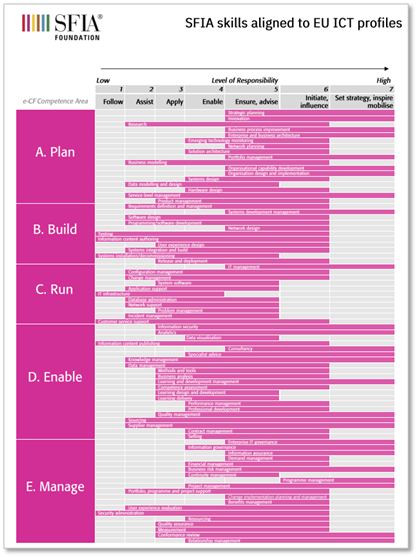SFIA skills for EU ICT Role Profiles
A listing of the SFIA skills mapped to the 30 European Union (EU) 30 ICT professional role profiles.
There are important considerations to be taken into account when using standard, generic role profiles and detailed guidance is provided below.
- For further discussion, about using standard profiles and our collaborations, contact the SFIA Foundation
Skills at a glance one-page summary of the SFIA skills and competency levels relevant to the 30 roles.
Using generic profiles
- When you review the list of role profiles you may feel there are some missing, some with the wrong names and some that you do not need.
- As with all generic profiles; they are not intended to be a rigid standard and the names of the roles and their content should be considered as just one way of categorising typical jobs in the industry.
This has two significant implications:
- Organisations adopting generic profiles (from the EU or other sources) should use them as a starting point only. Then adapt to their own specific organisational context and requirements.
- Other organisations (e.g. employers, national governments, professional bodies) will have different requirements than the EU. This may lead to a different set of generic profiles, differently named roles and different sets of responsibilities.
The SFIA framework provides a natural choice for organisations mapping skills and competency levels to generic profiles.
- If you are interested in creating or expanding on the definition of generic profiles mapped to SFIA please contact the SFIA Updates Manager.
The results are here and comprise:
- a summary, graphical view of all the SFIA skills which map to the 30 professional role profiles.
- A list of SFIA skills profiles for the 30 EU ICT Roles - each has a mapping of SFIA skills & levels aligned to the defined summary statement, mission, deliverables, and main tasks. We list all skills profiles and you can download a pdf by following the links in the table below.
- a "grid mapping" of the SFIA skills and skill levels mapped to each of the 30 profiles.
- a browsable view of the skills and skill levels relevant to the 30 roles.
- A discussion of EU ICT Role Profiles and SFIA Competency Profiles - which includes an approach to mapping role families instead of individual role profiles.
A summary view of all the SFIA skills mapped to the EU ICT profiles
Click on image to see full-size pdf.
Typical ICT Role Families
- Feedback from employers of ICT Professionals is that they find it helpful to position standardised ICT profiles in the context of typical ICT Role families.
- This allows for effective resource planning, recruitment, deployment and professional development.
- A typical Project Delivery role family (including the Project Manager role) is illustrated below. It illustrates that the richer content of SFIA can be used to expand on the singular role profiles to create a role family definition.
- The table below identifies potential for multi-level/role family definitions. If you are interested in expanding on possible multi-level/role family definitions, please contact the SFIA Updates Manager.

A list of SFIA skills profiles for the EU ICT Roles
This is a rich resource with SFIA skill and competency level descriptions for the 30 EU professional roles.
- The content and format for the skills profiles listed here is illustrative only and is for the specific purpose of this collaboration.
- The mapping and the format are not prescriptive.
- The standard role profiles may not be the best fit for your organization. Anyone using these documents should take care to apply the principles of SFIA to their own organisation and role design.
Grid mapping of the SFIA skills and skill levels mapped to each of the 30 profiles.
 Click to see the full-size document.
Click to see the full-size document.
Excel version of the grid document.
